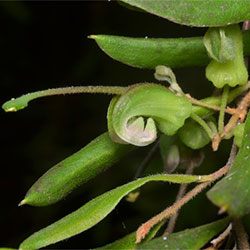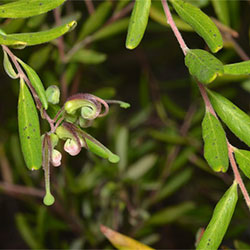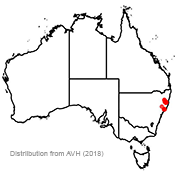Grevillea guthrieana
 |
 |
Guthrie's Grevillea
Grevillea guthrieana Olde & Marriott
Grevillea guthrieana occurs in a few scattered localities in the Northern Tablelands and Mid-North Coast regions of New South Wales (at Carrai Plateau, Oxley Wild Rivers National Park, Mount Banda Banda and near Booral). The species is listed as endangered in Australia and NSW, and is threatened by many factors including increasingly frequent fires, which can prevent successful regeneration.
Grevillea guthrieana grows naturally in shrubland on the top of steep rocky slopes and cliffs, riparian areas, or open forest with dense shrubby understorey. This shrub occurs in areas of low (20–130 m) and moderate (700–1000 m) altitude, with c. 1000 mm annual rainfall.
Grevillea guthrieana is a spreading shrub usually to 2 m high, although is known to reach 5 or 6 m. The species has bright green foliage and reddish stems, with attractive pendulous branchlets. The branchlets are covered with long hairs when young, and the leaf under-surface is also hairy. The narrow leaves are 2 to 6 cm long and less than 1 cm wide.
Although the green and maroon flowers forming at the end of branchlets are not particularly conspicuous they attract nectar-feeding birds. Flowering occurs mainly in spring (August to October) but can continue into summer, with fruits in spring and early summer.
Grevillea guthrieana may be confused with Grevillea granulifera, which has similar traits and distribution, however the latter has a silky leaf under-surface and slightly shorter pistils and fruit.
In the Australian National Botanic Gardens this species has proven itself to be relatively tolerant of most growing conditions, however appears to prefer moist, well-drained sandy-loam or rocky soils on slopes, in either open or semi-shaded positions. Grevillea guthrieana is frost tolerant, and prefers neutral to slightly acidic soils. Like many plants in the Proteaceae family, it likely has low phosphorus tolerance. Although it prefers moderate watering, the shrub can survive with limited rainfall (500mm) or heavy watering. It does not appear to be affected by insects or disease, and may even be tolerant of Armillaria root-rot fungus.
Propagation of G. guthrieana from cuttings is effective, and strikes well using low concentration rooting hormones or honey at most times of the year. Plants propagated from cuttings at the Australian National Botanic Gardens have been re-introduced into Oxley Wild Rivers National Park. The species also sets plentiful seed in the wild, which should germinate readily when fresh or with some pre-treatment. Grevillea guthrieana has also been grafted successfully onto Grevillea robusta.
Lucy Wenger, Volunteer Botanical Training Program Participant 2018
Name meaning: Grevillea guthrieanaGrevillea - after Charles Francis Greville (1749–1809), a British patron of botany and co-founder of the Royal Horticultural Society guthrieana - after Christine Guthrie (1953– ), Secretary and Treasurer of the Grevillea Study Group of the Australian Native Plants Society, and Editor of its Newsletter |
References:
Department of the Environment (2014) Approved Conservation Advice for Grevillea guthrieana. Canberra: Department of the Environment. Available at: http://www.environment.gov.au/biodiversity/threatened/species/pubs/64521-conservation-advice.pdf [Accessed 3 February 2018].
Olde, P.M. & Marriot, N.R. (1994) The Grevillea Book – Volume 2. Kangaroo Press: Kenthurst, NSW.
White, R. (2018) Horticulturist, Australian National Botanic Gardens, personal communication.
Wilson, A.J.G.(ed) (2000) Flora of Australia. Volume 17A, Proteaceae 2, Grevillea. ABRS/CSIRO Australia.
![An Australian Government Initiative [logo]](/images/austgovt_brown_90px.gif)


